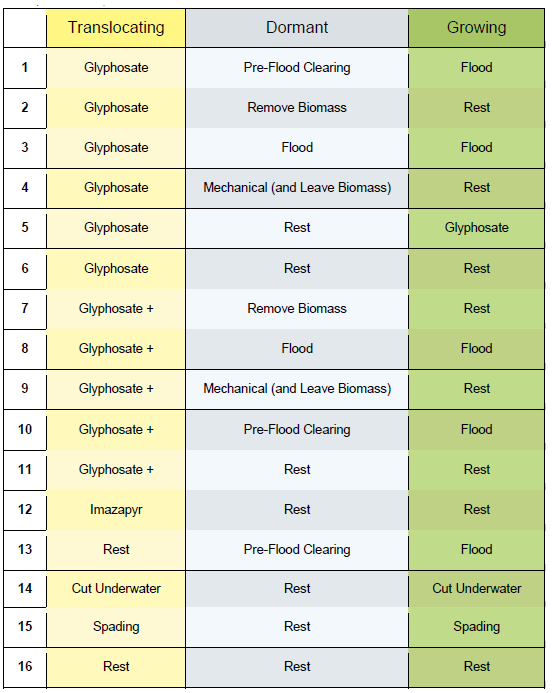July 30, 2018 – Etienne Herrick and Sydni Joubran, USGS Great Lakes Science Center
PAMF’s 16 Management Combinations: Where Do They Come From?
As PAMF participants across the Great Lakes basin collect and submit their monitoring data to the Web Hub throughout the month of July, the Core Science Team has been preparing to provide participants with their first round of management guidance in mid-August. Each year, all management units (MU) enrolled with PAMF will receive site-specific management guidance based on information included in the enrollment, monitoring, and management reports participants complete for their MUs. The management guidance corresponds to Phragmites’ three biological phases – translocating, dormant, and growing – and accordingly consists of a combination of three management actions to implement – one during each biological phase, with a total of 16 possible combinations (Table 1).
Table 1. PAMF’s management alternatives are a collection of 16 management combinations. Participants will receive guidance suggesting the optimal combination. Each combination is made up of separate management actions, one for each phase.

However, with so many different strategies for managing invasive Phragmites in use across the region, have you ever wondered how PAMF came to focus on those 16 combinations? While ideally PAMF would be inclusive of all types of management occurring throughout the region, the program was created to catalyze progress towards eradicating Phragmites by facilitating collective learning, which introduces some important programmatic constraints. As a science-based and data-driven program, PAMF’s developers recognized that reliable conclusions about the effectiveness of different control efforts can only be made if principles of sound-scientific discovery are followed, including the repetition principle. The more frequently a particular management combination is evaluated, the more confident PAMF can be in predicting that same combination’s outcomes at different sites with similar conditions. If, instead, each participant submits data on a different type of control effort, we may end up with small sample sizes and a limited ability to predict outcomes for various strategies. Consequently, the number of management combinations included in PAMF is limited to 16 to ensure enough data are generated for each combination such that reliable conclusions can be made over time about which outcomes to expect.
Beyond the number of management combinations to include, deciding upon what types of actions they would consist of and the order in which those would occur throughout the year was another major component of PAMF’s development. To inform these decisions, PAMF’s Technical Working Group (TWG), a group of twelve Phragmites experts from across the basin were brought together for a series of workshops. During those sessions, the TWG discussed which management actions seemed most common across the Great Lakes, which held promise for being both effective and cost-efficient, and how to best incorporate them into annual combinations. Based on these discussions and a number of productive exercises, the 16 management combinations listed in Table 1 were selected as a starting point for PAMF.
While for now we ask that participants use one of the original 16 combinations to bolster the predictive capacity of PAMF’s model, the relevance of those combinations will be re-evaluated each year in consideration of participant feedback and data. Emerging evidence from the greater Phragmites research and management community on the effectiveness of various management strategies will also be considered to ensure PAMF continues making meaningful contributions to invasive species work across the Great Lakes region. For more information about invasive Phragmites or PAMF, visit the PAMF Web Hub, the Great Lakes Phragmites Collaborative website, or contact us at pamf@glc.org!
